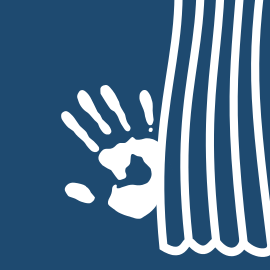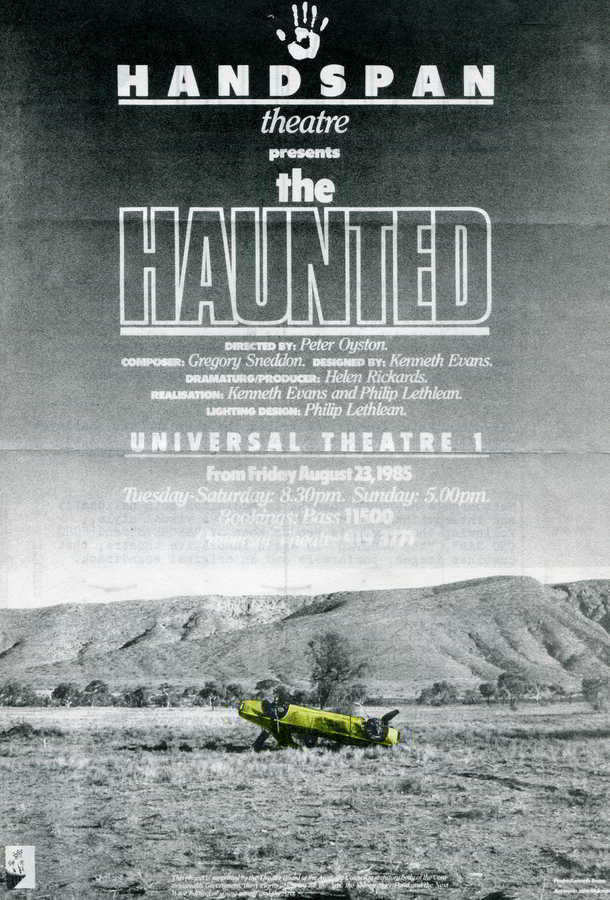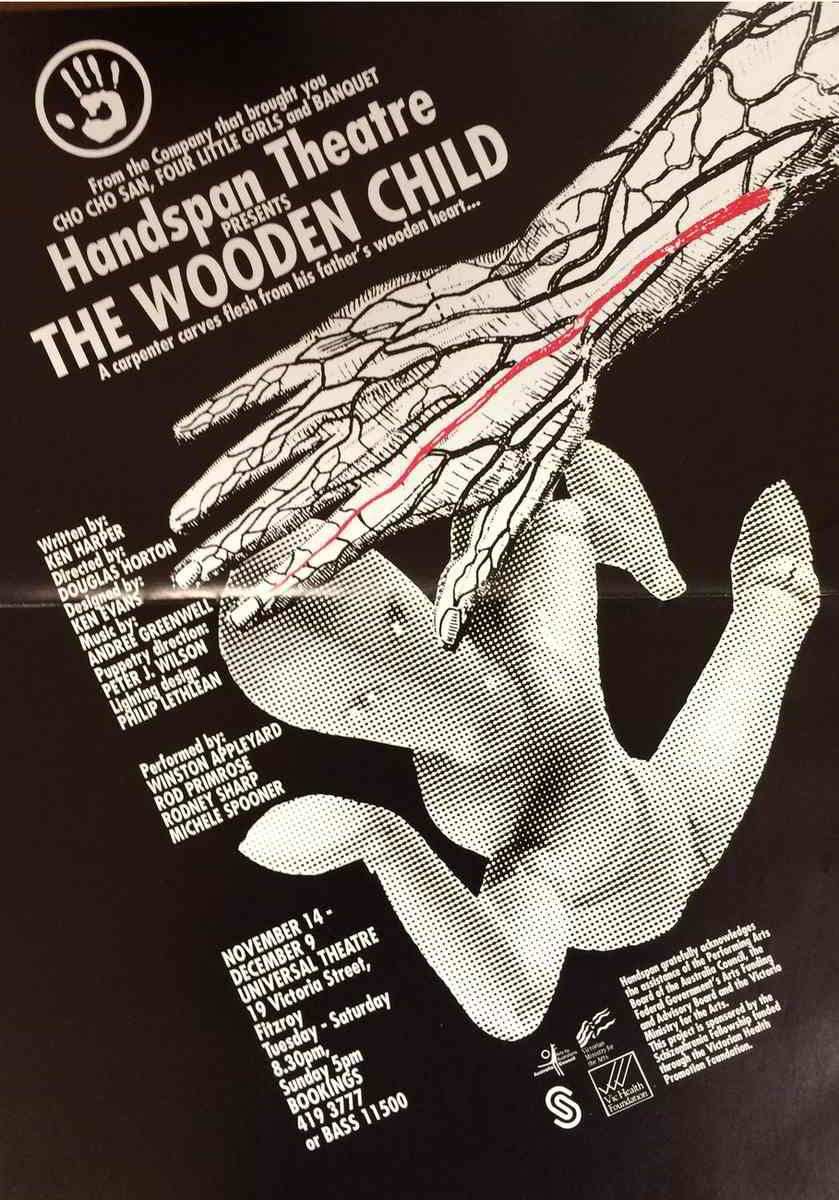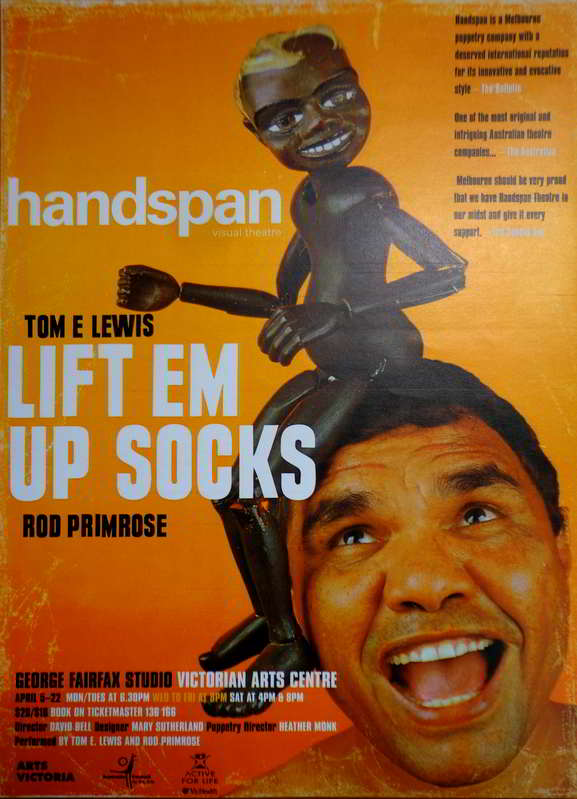
HANDSPAN THEATRE's first Mainstage production was Secrets which premiered in (1983). The work embodied all that the company aimed for in blending puppetry and human performance into a primarily visual experience. It broke down distinctions between puppet, prop and set to animate almost everything on stage. Secrets had no character personalities, dialogue, or plot, using instead a succession of metaphorical tableaux choreographed to a soundtrack that mixed fragments of music and spoken word.
Then came Cho Cho San (1984), and true to the company's resolve to continually explore new territory, it was something completely different. Cho Cho San was music theatre, re-imagining the story of Madame Butterfly with an original script and score. Where Secrets was a black theatre spectacle that made liberal use of smoke, Cho Cho San was intimate, spare and staged mostly in white. In Brechtian style, there was no attempt at theatrical illusion. Puppeteers were not hidden behind sets or obscured in black costumes. Some characters were played solely by actors, others alternately by a puppet or an actor as the dynamic of the story dictated. Musicians and their instruments were incorporated into the set.
These two productions contained the seeds of all the MAINSTAGE work that was to follow. The visual and the verbal were in constant interplay, mixed and matched as needed. The company never used a puppet if a person could do it better, but at the same time, never used words if animated image or design could say it all.
Handspan artists collaborated with Guest Artists from outside the company to create all of these works: Directors, Writers and Composers These collaborations challenged and enriched not only the work, but all who worked on their realisation.
Design was Handspan’s medium and two-thirds of these works were evolved in design collaborations with Handspan's Designer, Ken Evans and Lighting Designer Philip Lethlean with Handspan's on-going production ensemble of puppet makers and realisors. Mainstage shows mixed actors, visible puppeteers, animated costume and choreographed images with lighting designs that created the magical impact of dramatic illusion. Non-verbal interpretation of concepts, ideas and narrative was the cornerstone of Handspan’s practice. Smoke, mirrors and metaphors were basic tools for Handspan.
Some directors welcomed the challenge – others struggled. Some expected the impossible and often achieved it. Others grappled with frustration as their expectations were curtailed. Playwrights often found working with Handspan something of a nightmare – seeing their well- crafted text reduced or mangled beyond their expectations.
Composers and musicians were key collaborators in creative teams. No Handspan ensemble artists were musicians themselves but the symbiosis between sound and animation of image was crucial in all of Handspan’s work. Soundscape and design, seamlessly blended, made the best of these works.
Mainstage Works:
- The first, Nigel Triffit’s Secrets (1983) brought Handspan worldwide audiences and public recognition and Four Little Girls (1988) toured internationally for a decade.
- Some works were inspired by painters and animated their visual art style: Picasso’s Four Little Girls (1988); Viva La Vida - Frida Kahlo (1995) and Daze of Our Lives (1994) based on Mary Leunig’s cartoons.
- The Haunted (1985) and Lift 'Em Up Socks (2001) were ground-breaking cross-cultural projects with Australian indigenous artists; Banquet - A Parable of the Third World (1988) was based on cross-cultural exchange in India.
- Cho Cho San (1984) re-imagined Madame Butterfly; The Wooden Child (1990), Collido’s Pinocchio; Gulliver's Travels produced with the Melbourne Theatre Company, was based on Swift's classic text; Ask for the Captain (1994) interpreted Elliot’s Wasteland; and Dante - Through the Invisible (1996) Dante Aligheri's Divine Comedy.
- Tutta Casa Letto E Chiesa (1985) was performed in Italian, beginning Handspan's connections with Melbourne's Italo-Australian community
- Cho Cho San was music theatre. Raised by Wolves (1997), a rock ‘n roll extravaganza.
- Minds Eye (1996) with Back-to-Back Theatre and Miss Tanaka produced with Playbox Theatre (2001) were co-productions that combined the skills and styles of company's to create new Australian plays
- Waves of Change (1988) was a unique spectacle of Australian history, staged in a swimming pool
Handspan’s MAINSTAGE shows were in the general public eye, discussed and reported in myriad reviews. Critics’ viewpoints and opinion inform show descriptions in individual illustrated show listings which tell the story of these productions, and include data about who created and performed them; when they premiered, and where they toured.
Mainstage:




